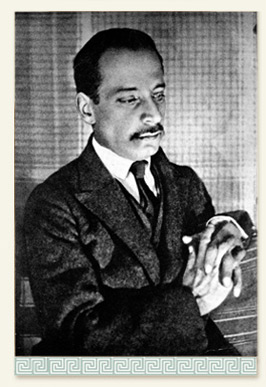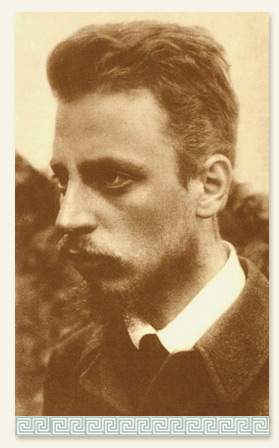Rainer Maria Rilke
Rainer Maria Rilke (4 December 1875 – 29 December 1926) was a Bohemian–Austrian poet and art critic. He is considered one of the most significant poets in the German language. His haunting images focus on the difficulty of communion with the ineffable in an age of disbelief, solitude, and profound anxiety: themes that tend to position him as a transitional figure between the traditional and the modernist poets.
He wrote in both verse and a highly lyrical prose. Among English-language readers, his best-known work is the Duino Elegies; his two most famous prose works are the Letters to a Young Poet and the semi-autobiographical The Notebooks of Malte Laurids Brigge. He also wrote more than 400 poems in French, dedicated to his homeland of choice, the canton of Valais in Switzerland.
1875–1896
He was born René Karl Wilhelm Johann Josef Maria Rilke in Prague, capital of Bohemia (then part of Austria–Hungary, now the Czech Republic). His childhood and youth in Prague were not especially happy. His father, Josef Rilke (1838–1906), became a railway official after an unsuccessful military career. His mother, Sophie ("Phia") Entz (1851–1931), came from a well-to-do Prague family, the Entz-Kinzelbergers, who lived in a house on the Herrengasse (Panská) 8, where René also spent many of his early years.
The relationship between Phia and her only son was colored by her mourning for a prior child, a daughter, who had died after only a week of life. During Rilke's early years Phia acted as if she sought to recover the lost girl through the boy by dressing him in girl's clothing. The parents' marriage fell apart in 1884.
His parents pressured the poetically and artistically talented youth into entering a military academy, which he attended from 1886 until 1891, when he left due to illness. From 1892 to 1895 he was tutored for the university entrance exam, which he passed in 1895. In 1895 and 1896, he studied literature, art history, and philosophy in Prague and Munich.
1897–1902
In 1897 in Munich, Rainer Maria Rilke met and fell in love with the widely traveled, intellectual woman of letters Lou Andreas-Salomé (1861–1937). (Rilke changed his first name from "René" to the more masculine Rainer at Lou's urging.) His relationship with this married woman, with whom he undertook two extensive trips to Russia, lasted until 1900. But even after their separation, Lou continued to be Rilke's most important confidante until the end of his life. Having trained from 1912 to 1913 as a psychoanalyst with Sigmund Freud, she shared her knowledge of psychoanalysis with Rilke.
In 1898, Rilke undertook a journey lasting several weeks to Italy. In 1899, he traveled with Lou and her husband, Friedrich Andreas, to Moscow where he met the novelist Leo Tolstoy. Between May and August 1900, a second journey to Russia, accompanied only by Lou, again took him to Moscow and Saint Petersburg, where he met the family of Boris Pasternak and Spiridon Drozhzhin, a peasant poet. Later, "Rilke called two places his home: Bohemia and Russia".
In autumn 1900, Rilke stayed at the artists' colony at Worpswede, where his portrait was painted by the proto-expressionist Paula Modersohn-Becker (illus. below). It was here that he got to know the sculptor Clara Westhoff (1878–1954), whom he married the following spring. Their daughter Ruth (1901–1972) was born in December 1901. However, Rilke was not one for a middle-class family life; in the summer of 1902, Rilke left home and traveled to Paris to write a monograph on the sculptor Auguste Rodin (1840–1917). Still, the relationship between Rilke and Clara Westhoff continued for the rest of his life.
 1902–1910
1902–1910
At first, Rilke had a difficult time in Paris, an experience that he called on in the first part of his only novel, The Notebooks of Malte Laurids Brigge. At the same time, his encounter with modernism was very stimulating: Rilke became deeply involved in the sculpture of Rodin, and then with the work of Paul Cézanne. For a time he acted as Rodin's amanuensis, also lecturing and writing a long essay on Rodin and his work. Rodin taught him the value of objective observation, and under this influence Rilke dramatically transformed his poetic style from the subjective and sometimes incantatory language of his earlier work into something quite new in European literature. The result was the New Poems, famous for the 'thing-poems' expressing Rilke's rejuvenated artistic vision. The poems of the New Poems and New Poems: The Other Part are highly wrought, using language and poetic form as a shaped and shaping material; to this extent the poems are often said to be 'things' in themselves. During these years, Paris increasingly became the writer's main residence.
The most important works of the Paris period were Neue Gedichte (New Poems) (1907), Der Neuen Gedichte Anderer Teil (Another Part of the New Poems) (1908), the two "Requiem" poems (1909), and the novel The Notebooks of Malte Laurids Brigge, started in 1904 and completed in January 1910.
1910–1919
Between October 1911 and May 1912, Rilke stayed at the Castle Duino, near Trieste, home of Countess Marie of Thurn und Taxis. There, in 1912, he began the poem cycle called the Duino Elegies, which would remain unfinished for a decade because of a long-lasting creativity crisis.
The outbreak of World War I surprised Rilke during a stay in Germany. He was unable to return to Paris, where his property was confiscated and auctioned. He spent the greater part of the war in Munich. From 1914 to 1916 he had a turbulent affair with the painter Lou Albert-Lasard.
Rilke was called up at the beginning of 1916, and he had to undertake basic training in Vienna. Influential friends interceded on his behalf, and he was transferred to the War Records Office and discharged from the military on 9 June 1916. He spent the subsequent time once again in Munich, interrupted by a stay on Hertha Koenig's Gut Bockel in Westphalia. The traumatic experience of military service, a reminder of the horrors of the military academy, almost completely silenced him as a poet.
1919–1926
On 11 June 1919, Rilke traveled from Munich to Switzerland. The outward motive was an invitation to lecture in Zürich, but the real reason was the wish to escape the post-war chaos and take up his work on the Duino Elegies once again. The search for a suitable and affordable place to live proved to be very difficult. Among other places, Rilke lived in Soglio, Locarno, and Berg am Irchel. Only in mid-1921 was he able to find a permanent residence in the Chateau de Muzot in the commune of Veyras, close to Sierre in Valais. In an intense creative period, Rilke completed the Duino Elegies within several weeks in February 1922. Before and after, Rilke rapidly wrote both parts of the poem cycle Sonnets to Orpheus containing 55 entire sonnets. Both works together have often been taken as constituting the high points of Rilke's work. In May 1922, Rilke's patron Werner Reinhart bought and renovated Muzot so that Rilke could live there rent-free.
During this time, Reinhart introduced Rilke to his protégé, the Australian violinist Alma Moodie. Rilke was so impressed with her playing that he wrote in a letter: What a sound, what richness, what determination. That and the "Sonnets to Orpheus", those were two strings of the same voice. And she plays mostly Bach! Muzot has received its musical christening....
Rilke's grave
From 1923 on, Rilke increasingly had to struggle with health problems that necessitated many long stays at a sanatorium in Territet, near Montreux, on Lake Geneva. His long stay in Paris between January and August 1925 was an attempt to escape his illness through a change in location and living conditions. Despite this, numerous important individual poems appeared in the years 1923–1926 (including Gong and Mausoleum), as well as the abundant lyrical work in French.
Only shortly before his death was Rilke's illness diagnosed as leukemia. The poet died on 29 December 1926 in the Valmont Sanatorium in Switzerland, and was buried on 2 January 1927 in the Raron cemetery to the west of Visp.
Rilke had chosen as his own epitaph this poem:
Rose, oh reiner Widerspruch, Lust,
Niemandes Schlaf zu sein unter soviel
Lidern.
Rose, oh pure contradiction, delight
of being no one's sleep under so
many lids.
Rilke's literary style
Figures from Greek mythology (e.g. Apollo, Hermes, Orpheus) recur as motifs in his poems and are depicted in original interpretations (e.g. in the poem Orpheus. Eurydice. Hermes, Rilke's Eurydice, numbed and dazed by death, does not recognize her lover Orpheus, who descended to hell to recover her). Other recurring figures in Rilke's poems are angels, roses and a character of a poet and his creative work.
Rilke often worked with metaphors, metonymy and contradictions (e.g. in his epitaph, the rose is a symbol of sleep – rose petals are reminiscent of closed eye lids).
Rilke's little-known 1898 poem, "Visions of Christ" depicted Mary Magdalene as the mother to Jesus' child.
Quoting Susan Haskins:
It was Rilke's explicit belief that Christ was not divine, was entirely human, and deified only on Calvary, expressed in an unpublished poem of 1893, and referred to in other poems of the same period, which allowed him to portray Christ's love for Mary Magdalene, though remarkable, as entirely human.
Text is cited from Wikipedia and liscensed under Creative Commons http://en.wikipedia.org/wiki/Rainer_Maria_Rilke



 1902–1910
1902–1910